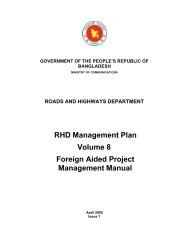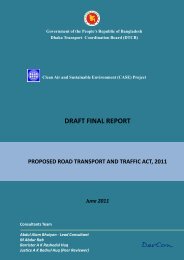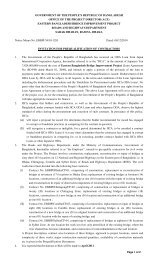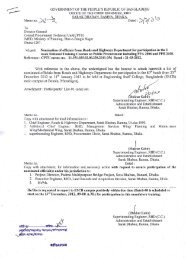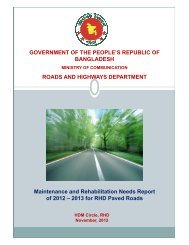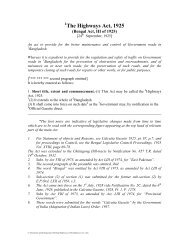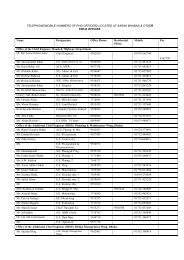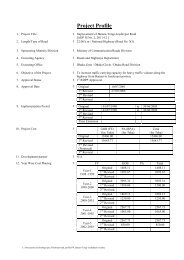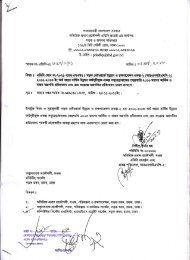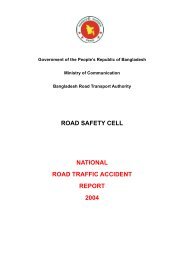Issue 2 - Roads and Highways Department
Issue 2 - Roads and Highways Department
Issue 2 - Roads and Highways Department
You also want an ePaper? Increase the reach of your titles
YUMPU automatically turns print PDFs into web optimized ePapers that Google loves.
RHD Newsletter<br />
Four Return having Completed Masters Overseas<br />
Four Assistant Engineers of the <strong>Department</strong> have recently returned from overseas. Mr. Shafiqul Alam, Mr. Mahbubl Alam,<br />
<strong>and</strong> Mr. Syed Moinul Hasan all went to the UK <strong>and</strong> Mr. Md. Nazmus Sadat went to Australia. All four went for higher level<br />
studies, paid for by direct DFID assistance facilitated by the British Council <strong>and</strong> planned & programmed by IDC-3. The<br />
following texts are extracts from the dissertation of 3 of these 4 returned engineers.<br />
Cheaper materials for road<br />
base suggested:<br />
Use of cement stabilised brick<br />
aggregate-s<strong>and</strong>-soil mix as road<br />
base material gives satisfactory<br />
results in pavement construction.<br />
This was revealed by Mr. Md.<br />
Shafiqul Alam, Assistant Engineer,<br />
Road Research Laboratory during<br />
his research work as a part of<br />
fulfilment of M Phil degree in the<br />
University of Birmingham recently.<br />
He believes that, being a cheaper<br />
<strong>and</strong> stronger technique the<br />
implementation of his findings<br />
could start a new phase in<br />
pavement construction.<br />
The research suggests that, in<br />
contrast to current practice of using<br />
mixes of low grade brick aggregate<br />
<strong>and</strong> fine s<strong>and</strong>, an addition of some<br />
amount of soil <strong>and</strong> small<br />
percentage of cement would give<br />
substantial strength in the road base<br />
in terms of CBR value. The<br />
presence of montmorillonite<br />
mineral in the locally available clay<br />
contributes towards that strength.<br />
An assessment by the researcher<br />
indicated that the newly proposed<br />
mix is cheaper than RHD st<strong>and</strong>ard<br />
stone-aggregate road base mix.<br />
In another finding during his<br />
research work, Mr. Shafiq opined<br />
that an open graded drainage layer<br />
between the surface <strong>and</strong> road base<br />
facilitates faster drainage of surface<br />
intrusions thereby helping<br />
serviceability <strong>and</strong> longevity of the<br />
road pavement. Most of the<br />
pavements in Bangladesh are made<br />
of weak brick aggregates that<br />
deteriorate rapidly due to trapped<br />
moisture not finding adequate<br />
drainage. He argued that this<br />
intermediate drainage layer would<br />
help draining out the entrapped<br />
water through the edges of the<br />
road.<br />
Road Deterioration Model<br />
Calibrated:<br />
The Road Deterioration model of<br />
HDM-4 has been calibrated to meet<br />
the local Bangladeshi condition <strong>and</strong><br />
environment. The series of studies<br />
required for this purpose were<br />
conducted by Mr. Mahbubul Alam<br />
Khan, Assistant Engineer, Road<br />
Research Laboratory during his M<br />
Phil course in the University of<br />
Birmingham. It is expected that his<br />
findings would help the HDM model<br />
to predict the performance of<br />
pavement with increased degree of<br />
reliability that is essential to determine<br />
representative life cycle of the<br />
pavement in Bangladesh. The findings<br />
of Mr. Mahbub have also been<br />
validated for existing climate <strong>and</strong><br />
traffic conditions of Bangladesh. The<br />
HDM model in Bangladesh is now<br />
using the road deterioration values as<br />
suggested by the consultants on the<br />
basis of their experience. Mr. Mahbub<br />
has been posted to HDM circle after<br />
his return from Birmingham.<br />
The 4th version of the Highway<br />
Development <strong>and</strong> Management<br />
(HDM4) model has essentially two<br />
sub-models: Road Deterioration<br />
Work-effects model <strong>and</strong> Road User<br />
Effects model. Mr. Mahbub calibrated<br />
RDWE model considering the<br />
common types of road defects of<br />
Bangladesh such as cracking,<br />
ravelling, potholing, edge-breaking,<br />
rutting <strong>and</strong> roughness progression. He<br />
finds out different sets of calibration<br />
factors for Asphalt mix on Granular<br />
Base <strong>and</strong> Surface treatment on<br />
Granular Base types pavement <strong>and</strong><br />
also suggests two sets of calibration<br />
adjustment factors for them<br />
separately. These maintenance<br />
treatments e.g., manual seal, surface<br />
treatment <strong>and</strong> overlay have also been<br />
calibrated by the researcher to<br />
accurately reflect the after workeffects<br />
of the treatment.<br />
Real-Time Communication:<br />
Switched Ethernet Networks can<br />
also be used for real time<br />
communications. This was the<br />
outcome of the thesis of Mr. Syed<br />
Moinul Hasan, Asstt. Engr., HDM<br />
circle. He has recently completed M<br />
Sc. on IT Networking Systems from<br />
the University of Derby.<br />
Over the past few years there has<br />
been growing interest among IT<br />
users to integrate voice, video <strong>and</strong><br />
data over communication networks.<br />
Voice <strong>and</strong> video data in particular,<br />
are distinguished from other data<br />
(e.g., email, text files) because of<br />
their time constrained nature. These<br />
are to be delivered to the receiver<br />
end within a time interval else they<br />
become useless. When words arrive<br />
delay at either end during a<br />
telephonic conversation the necessity<br />
of real time communication can be<br />
realized. So audio <strong>and</strong> video data<br />
require real-time communication.<br />
RHD uses Switched Ethernet<br />
technology in its local area network.<br />
Though technically it was not<br />
suitable for time constrained<br />
communication recent advancements<br />
in Switched Ethernet technology<br />
now allow users to communicate in a<br />
real time environment. As audio <strong>and</strong><br />
video data are given priority over<br />
other data so they are treated<br />
specially by the Switch in an<br />
Ethernet network.<br />
Mr. Moinul's work may play an<br />
important role in implementing voice<br />
mail in RHD. Moreover, video<br />
conferencing could be done in future<br />
between RHD HQ <strong>and</strong> field offices<br />
if the access layer technology is<br />
equipped with Switched Ethernet.<br />
Even GIS applications might become<br />
easily downloadable using this<br />
enhanced implementation outline.<br />
6 . . . . . . . . . . . . . . . . . . . . . . .



